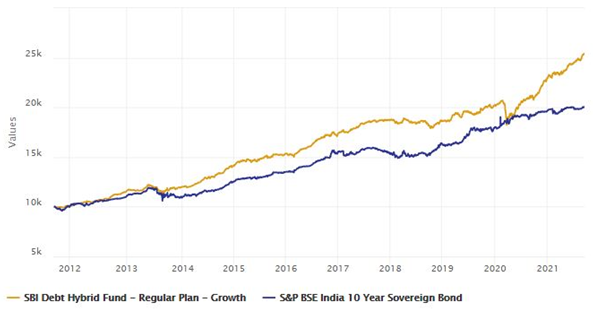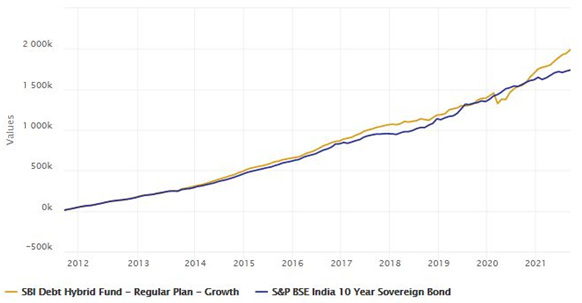SBI Debt Hybrid Fund: A stable conservative hybrid fund for low interest rate regime

With interest rates of traditional fixed income products on the decline for quite some time, many investors are looking at alternative investment options. Debt mutual funds offer investors a variety of products for different risk appetites, investment tenures and investment needs. However, for investors who are willing to take a small amount of risk, debt oriented hybrid funds or conservative hybrid funds can provide relatively stable investment experience with potential of superior returns over sufficiently long investment tenures.
Conservative Hybrid Funds
These are hybrid mutual funds schemes, which invest primarily in debt and money market instruments, but also have some allocations to equity and equity related securities. As per SBI's mandate, conservative hybrid funds must invest at least 75% of their assets in debt and money market instruments and at least 25% in equity and equity related securities. The debt allocation of these schemes ranges from 75% to 90% while the equity allocation ranges from 10% to 25%.
SBI Debt Hybrid Fund
In this blog post, we will review one of the top performing conservative hybrid funds, SBI Debt Hybrid Fund. The scheme was launched in April 2001. The scheme has Rs 3894 crores of Assets under Management (AUM) as on 31st August 2021. The expense ratio of the scheme is 1.1%. Mr. Ruchit Mehta, Ms. Mansi Sajeja and Mr. Mohit Jain are the fund managers of this scheme since 2011.
Advisorkhoj has a tool for ranking top performing funds based on performing consistency. In this tool, we look at average rolling returns of a scheme and how consistently it has beaten the fund category average across different market conditions based on our proprietary algorithm. , SBI Debt Hybrid Funds is one of the most consistent performers in the conservative hybrid funds category (see our tool ->Consistent Performing Mutual Funds – Conservative Hybrid Funds).
Long term performance
The chart below shows the growth of Rs 10,000 lump sum investment in SBI Debt Hybrid Fund over the last 10 years versus the S&P BSE 10 year Sovereign Bond Index (as a proxy for debt as an asset class). You can see that the scheme has been able to provide significantly higher returns in the long term than debt due to the equity component of the portfolio.

Source: Advisorkhoj Research, as on 16th September 2021. Disclaimer: Past performance may or may not be sustained in the future
Much Smaller Downside Risks
The table below shows the impact of the 5 largest drawdowns in the equity market over the last 10 years on SBI Debt Hybrid Fund and Nifty 50 TRI. You can see that drawdown on the SBI Debt Hybrid Fund was much smaller than that on Nifty. The asset allocation of the scheme was able to limit the downside risks for investors in volatile market.

Source: Advisorkhoj Research, as on 16th September 2021. Disclaimer: Past performance may or may not be sustained in the future
Quicker recovery
The table below shows how long the scheme and the benchmark took to recover all the losses in the 5 largest drawdowns over the past 10 years. You can see that SBI Debt Hybrid Fund recovered much faster than the Nifty, except in 2013 when both the bond and equity markets where highly volatile due to the impact of taper tantrum on financial markets.

Source: Advisorkhoj Research, as on 16th September 2021. Disclaimer: Past performance may or may not be sustained in the future
Suitable for SIPs
The chart below shows the growth of Rs 10,000 monthly Systematic Investment Plan (SIP) in SBI Debt Hybrid Fund versus S&P BSE 10 year Sovereign Bond Index over the last 10 years (ending 16th September 2021). The 10 year SIP returns (XIRR) of the scheme was 9.8%, which is higher than the usual average debt fund returns.

Source: Advisorkhoj Research, as on 16th September 2021. Disclaimer: Past performance may or may not be sustained in the future
Suitable for SWP
Let us assume that you invested Rs 10 Lakhs in SBI Debt Hybrid Fund on 19th September, 2011. You started a monthly Systematic Withdrawal Plan (SWP) of Rs 5,000 from the 1st of next month. Please note that this is a hypothetical example purely for the purpose of demonstrating how SWP can work over long periods of time. Let us see the results of this hypothetical SWP after 10 years, as on 16th September 2021.

Source: Advisorkhoj Research, as on 16th September 2021. Disclaimer: Past performance may or may not be sustained in the future
You can see in the chart above that you would have continued your SWP for 10 years, withdrawing Rs 6 Lakhs through 120 monthly instalments. You can also see in the chart above that value of your investment in SBI Debt Hybrid Fund, despite the regular withdrawals appreciated by more than 50% (as on 16th September 2021). This means that you can continue your SWP for many more years with the potential of creating even more wealth. The table below shows the summary of the SWP over the last 10 years.

Source: Advisorkhoj Research, as on 16th September 2021. Disclaimer: Past performance may or may not be sustained in the future
Tax Advantage of SBI Debt Hybrid Fund
The other big advantage which mutual funds enjoy over traditional fixed income products is beneficial tax treatment. While traditional fixed income products like Bank Fixed Deposits or Post Office Small Savings Schemes are taxed as per the income tax rate of the investors, capital gains (profits) in conservative hybrid funds made over a 3 years plus investment tenors are taxed at 20% after allowing for indexation benefits. Indexation benefits can reduce your tax obligation considerably. Let us understand this with the help of an example.
Why invest in SBI Debt Hybrid Fund?
- Higher potential returns than traditional fixed income products in the long term due to the equity kicker
- Potential to beat inflation on post tax basis in the long term due to the equity component
- With the economy in recovery mode in the post COVID scenario, equity has the potential to deliver superior returns to investors in the medium to long term
- Downside risks in the near term limited due to high asset allocation to debt – minimum 75%
- Tax advantage compared to traditional fixed income products, as explained above
- Suitable for long term Systematic Withdrawal Plans (moderate withdrawal rate), as explained above
Who should invest in SBI Debt Hybrid Fund?
- Investors primarily looking for stable returns along with some capital appreciation
- Investors with moderately low to moderate risk appetites
- Investors with minimum 3 to 5 years investment tenures
- SBI Debt Hybrid Fund is suitable for senior citizens or investors nearing retirement looking to build corpus for post retirement income
Investors should consult with their financial advisors if SBI Debt Hybrid Fund is suitable for their investment needs.
Mutual Fund Investments are subject to market risk, read all scheme related documents carefully.
RECOMMENDED READS
- Demystifying debt mutual funds
- Why Balanced Funds may be the best investments for new mutual fund investors
- How do you know if you have good funds in your mutual funds portfolio: part 1
- Know your mutual fund tax obligations to manage your investments effectively
- Asset Allocation is much more important than fund selection
LATEST ARTICLES
- SBI Dynamic Asset Allocation Active FOF: A smart asset allocation solution in shifting markets
- Your perfect Gift for your little ones this Childrens Day: SBI Magnum Childrens Benefit Fund Investment Plan One of the best performing funds for your childs future
- Magnum Hybrid Long Short Fund: A smart investment option in challenging conditions
- Delivering Returns with Resilience: SBI Multicap Funds proven multicap strategy
- SBI Equity Hybrid Fund: One of the top performing hybrid funds in current market conditions
Quick Links
Follow SBI MF
More About SBI MF
POST A QUERY





